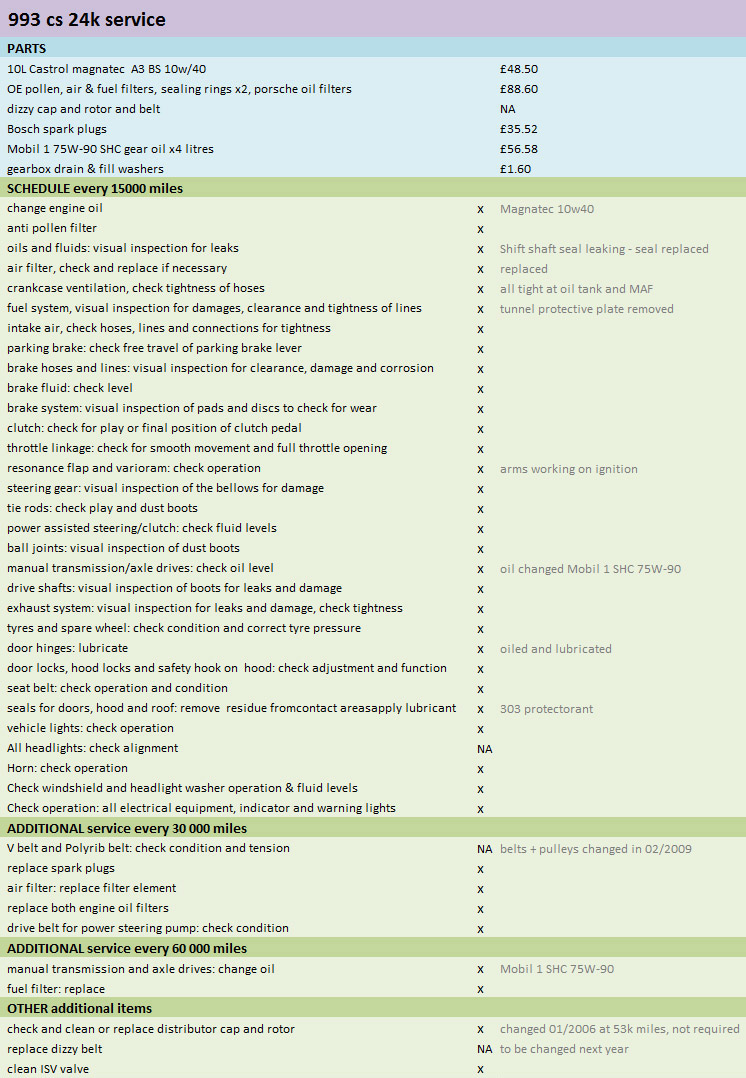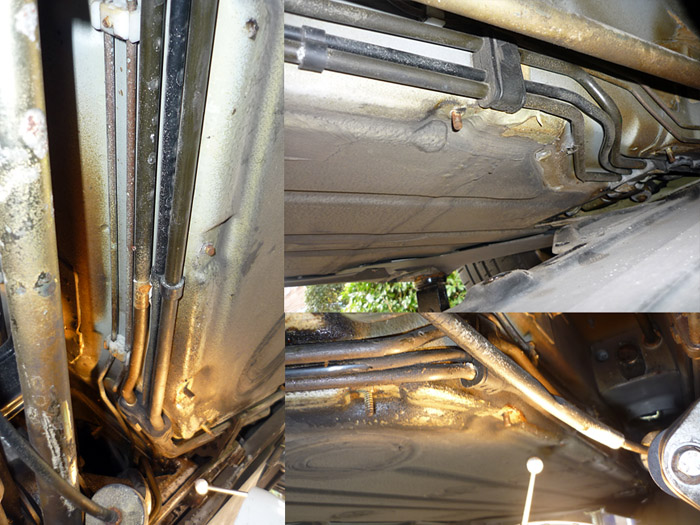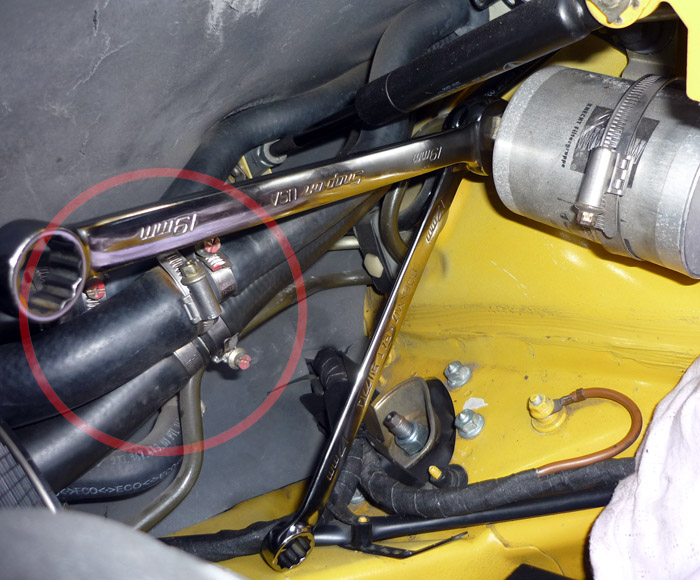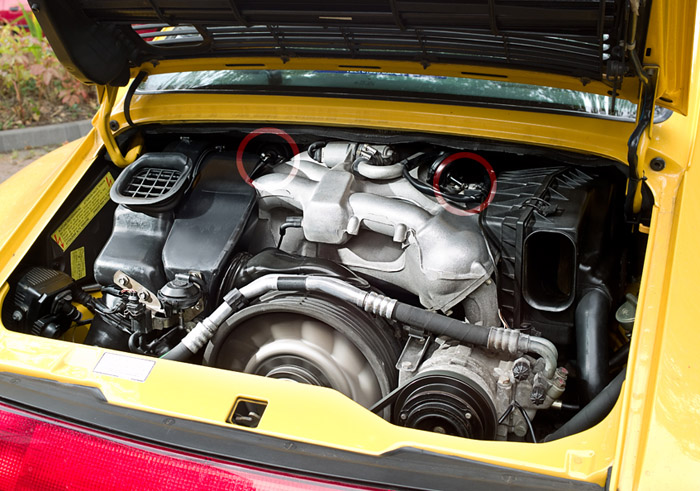24k-30k-60k Service - 60k schedule It's march 2010. Last time the 993 was serviced was only a few thousand miles ago during Febuary of last year 2009 at the well known UK independent Paragon. Instead of paying a whopping 280+vat for just a yearly oil change back at the sussex dealership I have decided to give the car not only a full 24k service with oil filters and spark plugs, but also perform all the additional 30k and 60k scheduled maintenance (gearbox oil, fuel filter, V belt and PAS belt check). As if that wasn't enough I will also be checking and renewing (wherever applicable) both distributer caps, rotors and the dizzy belt, something that isn't even included in the porsche maintenance schedule. For the absolute icing on the cake, I'll also be removing and cleaning the ISV valve. These last two, the twin distributer belt and the Idle stabiliser Valve, if you don't know when they were last looked at then it might be advisable to find out. Failure of the dizzy belt is relatively uncommon (since it was fixed from the 964 'sans vent' days) but failures have been documented (and it can be catastrophic) and the fact that it has failed is not always immediately obvious. It's probably worth looking at the sprak plug leads as well if they've never been replaced. Check for cracking and signs of perishing and consdier a new set for around £300 if they look old. Here are links to the other parts of the servicing: 1. 60k service schedule
Let's look at my the offical Porsche schedule and my record for the car.
Here you can see all the parts I bought and then all the official Porsche maintenance. I have made this available here as a blank excel file. I put a cross next to everything that I carried out. The headlights were not checked, the belts I elected to miss as they were done just 6k miles ago last february so are not due. The Dizzy belt will be changed next year along with the cap and rotors which were found to be in good working condition. I did however clean all the contacts for good measure.
Most of the service items are self-explanatory to anyone with a small degree of mechanical knowledge. Here are some notes on some of the items which might not be that obvious. Fuel system, visual inspection for damages, clearance and tightness of lines
I performed this mostly by removing the central tunnel protective cover and also the cover that sits under the fuel pump. As i changed the fuel filter I was also able to quickly take a look at the fuel lines in the engine bay as well.
crankcase ventilation, check tightness of hoses Check the hoses that run into the oil tank forward of the offiside rear wheelarch. You can do this when yuo perform the oil change. Also, behind the airbox there are 3 breather hoses which should also be checked for tightness. They have jubilee clips halfway down their lengths. You can see these in my pic blow. Ignore the spanners and the fuel filter but you can see the hoses running at the back towards the back of the varioram intake manifold.
throttle linkage: check for smooth movement and full throttle opening For this one just get someone to press the accelerator whilst you are out back with your hand feeling if there is any more play left in the linkage once the pedal is fully depressed. The mechanism is at the top just behind and to the left of the ISV valve (the metal cylinder that sits on top of your intake manifold). You will need to wedge your hand underneath the engine bay lining. Just be careful that you don't get your fingers caught when the pedal is released.
resonance flap and varioram: check operation
For this run the engine for a few minutes to build up the vacuum. Then have someone turn the ignition on whilst you are peering into the engine bay. You should see the two varioram arms move as circled in the picture above. If they don't then check there is a vacuum present by pulling off one of the vac hoses (e.g. the one that goes onto the front spin of the intake manifold seen just above the fan in my pic on the black elbow connector). If there is no vacuum then you will need to investigate further. If there is a vacuum then you could have problems with the varoiram flaps and it might not be functioning properly.
steering gear: visual inspection of the bellows for damage + tie rods: check play and dust boots This was easy enough for me seeing as so much suspension work has been done on the car recently. For the tie rods you want to feel the inner ball joint that lives under the steering rack gaiter whilst someone else rocks the wheel N&S, E&W. Feel for any play there.
CONCLUSION So there you have it. 60,000 miles worth of servicing and I dread to think what it would have cost if I hadn't done my own labour. Probably in excess of £1200 given that just a basic 24k is around £800+vat and that will not include gearbox oil, fuel filters and the like. I am under my car a hell of a lot so in terms of boots, ball joint rubbers, oil leaks, brake pipes and fuel lines I pretty much known what's going on on a month to month basis. The only item that did show up which needed repair was a leaking gearbox shift shaft seal. I have noticed since the service that the car's engine note seems to be deeper and stronger, almost as if it has more substance to it and is less 'thin'. I am not sure I can comment on actual performance yet but will do when I get the chance.
|



